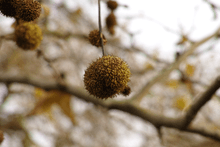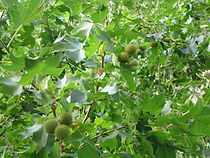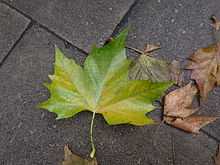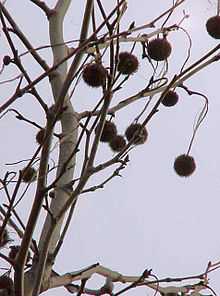Platanus × acerifolia
| Platanus × acerifolia | |
|---|---|
 | |
| London Plane seed ball | |
| Scientific classification | |
| Kingdom: | Plantae |
| (unranked): | Angiosperms |
| (unranked): | Eudicots |
| Order: | Proteales |
| Family: | Platanaceae |
| Genus: | Platanus |
| Species: | P. × acerifolia |
| Binomial name | |
| Platanus × acerifolia (Aiton) Willd. | |
| Synonyms[1] | |
| |
Platanus × acerifolia, London plane,[2] London planetree, or hybrid plane, is a tree in the genus Platanus. It is usually thought to be a hybrid of Platanus orientalis (oriental plane) and Platanus occidentalis (American sycamore). Some authorities think that it may be a cultivar of P. orientalis.
Description

The London plane is a large deciduous tree growing 20–30 m (66–98 ft), exceptionally over 40 m (131 ft) tall, with a trunk up to 3 m (10 ft) or more in circumference. The bark is usually pale grey-green, smooth and exfoliating, or buff-brown and not exfoliating. The leaves are thick and stiff-textured, broad, palmately lobed, superficially maple-like, the leaf blade 10–20 cm (4–8 in) long and 12–25 cm (5–10 in) broad, with a petiole 3–10 cm (1–4 in) long. The young leaves in spring are coated with minute, fine, stiff hairs at first, but these wear off and by late summer the leaves are hairless or nearly so. The flowers are borne in one to three (most often two) dense spherical inflorescences on a pendulous stem, with male and female flowers on separate stems. The fruit matures in about 6 months, to 2–3 cm diameter, and comprises a dense spherical cluster of achenes with numerous stiff hairs which aid wind dispersal; the cluster breaks up slowly over the winter to release the numerous 2–3 mm seeds.
It shares many visual similarities with Platanus occidentalis (American sycamore), of which it is derived; however, the two species are relatively easy to distinguish, considering the London plane is almost exclusively planted in urban habitats, while P. occidentalis is most commonly found growing in lowlands and alluvial soils along streams.[3]
Origin

It was first recorded in Spain in the 17th century, where P. orientalis and P. occidentalis had been planted in proximity to one another. The leaf and flower characteristics are intermediate between the two parent species, the leaf being more deeply lobed than P. occidentalis but less so than P. orientalis, and the seed balls typically two per stem (one in P. occidentalis, 3-6 in P. orientalis). The hybrid is fertile, and seedlings are occasionally found near mature trees.
Controlled reciprocal pollinations between P. occidentalis and P. orientalis resulted in good yields of germinable seed and true hybrid seedlings. Crosses of both species, as females, with P. racemosa and P. wrightii produced extremely low yields of germinable seed, but true hybrids were obtained from all interspecific combinations. Apomixis (asexual reproduction from non-fertilized seeds) appeared common in P. orientalis.[4]
In 1968 and 1970, Frank S. Santamour, Jr., recreated the P. orientalis, P. occidentalis cross using a P. orientalis of Turkish origin with American sycamores (P. occidentalis). The offspring were evaluated following several years of exposure to anthracnose infection. Two selections, 'Columbia' and 'Liberty', were released in August, 1984.[4][5]
Taxonomy
Platanus × acerifolia was first formally described in the botanical literature by the Scottish botanist William Aiton in his 1789 work Hortus Kewensis as a variety of P. orientalis.[6] Aiton described this variety with a two-word Latin diagnosis, "foliis tranſverſis" (using the long s or "foliis transversis" without it), and called it the Spanish plane tree.[7] In 1805, Carl Ludwig Willdenow chose to elevate Aiton's variety to species rank, publishing the new species P. acerifolia in the fourth edition of Species Plantarum.[8][9] The species name was then modified to include the multiplication symbol to indicate its suspected hybrid parentage. The other name commonly used for this taxon, Platanus × hispanica auct. non Mill. ex Münchh., is a nomen dubium based on an uncertain description.[10][11]
Cultivation



Stereo image | ||
| ||
| ||
| ||
| ||
| Avenue of London plane trees on Jesus Green. |
The London plane is very tolerant of atmospheric pollution and root compaction, and for this reason it is a popular urban roadside tree. It is now extensively cultivated in most temperate latitudes as an ornamental and parkland tree, and is a commonly planted tree in cities throughout the temperate regions of the world, in London and many other cities. It has a greater degree of winter cold tolerance than P. orientalis, and is less susceptible to anthracnose disease than P. occidentalis. The tree has gained the Royal Horticultural Society's Award of Garden Merit.[12]
The tree is fairly wind-resistant. However, it has a number of problems in urban use, most notably the short, stiff hairs shed by the young leaves and the dispersing seeds; these are an irritant if breathed in, and can exacerbate breathing difficulties for people with asthma. The large leaves can create a disposal problem in cities. These leaves are tough and sometimes can take more than one year to break down if they remain whole.
London planes are often pruned by a technique called pollarding. A pollarded tree has a drastically different appearance than an unpruned tree, being much shorter with stunted, club-like branches. Although pollarding requires frequent maintenance (the trees must usually be repruned every year), it creates a distinctive shape that is often sought after in plazas, main streets, and other urban areas.
In New York City
According to the New York City Department of Parks and Recreation the symbol of that organization is a cross between the leaf of the London plane and a maple leaf. It is prominently featured on signs and buildings in public parks across the city. The tree is on the NYC Parks Department's list of restricted use species for street tree planting because it constitutes more than 10% of all street trees.
In Australia
In Australia, the London plane is used extensively as a street tree in major cities, particularly Sydney, Melbourne and Adelaide. The tree is commonly used because of its resilience to warm weather, its benefits as a shade tree, resistance to breakage and tolerance of urban pollution.
Timber
When quarter-sawn the timber has a distinctive and highly decorative appearance of dark reddish-brown flecks against a lighter background and is known as Lacewood.[13]
Cultivars and varieties


- Augustine Henry. This is a tall growing variety, with very large, pale green leaves. It produces a strong leader and a cylindrical trunk.[4]
- Bloodgood, This is one of the first cultivars to be selected for anthracnose resistance. It is a rounded tree with deep green leaves that turn a poor yellow in fall. The plant tolerates poor cultural conditions, including heat, drought and poor soil. Recent observations indicate susceptibility to ozone.
- Columbia. Resists mildew and anthracnose, this tree has deeply lobed, dark green leaves.[14]
- Liberty. A U.S. National Arboretum introduction, this pyramidal tree grows vigorously. It shows good tolerance for mildew, anthracnose, heat and drought.[14]
- Metzam (Metroshade), A new introduction that grows strongly with a pyramidal habit, this cultivar is also said to be disease resistant with lustrous green foliage that emerges with a reddish cast.[14]
- Mirkovec. Has a dwarf, shrubby habit and unusual variegated lobed leaves with pink, cream and bronze regions.[14]
- Pyramidalis. A cultivar or cultivar group common in London, with rich glossy green leaves, and a characteristic tendency to produce straight branches, compared to sinuous ones in other forms.[4]
- Suttneri. Leaves are variegated creamy white.
- Yarwood. Very resistant to powdery mildew and highly susceptible to anthracnose. Poor structure. Being abandoned in California.[15]
References
- ↑ Synonymy - Platanus × acerifolia. Northern Ontario Plant Database. Accessed online: 9 January 2011.
- ↑ "BSBI List 2007" (xls). Botanical Society of Britain and Ireland. Archived from the original on 2015-02-25. Retrieved 2014-10-17.
- ↑ O. O. Wells, R. C. Schmidtling. "Sycamore". Retrieved 23 December 2013.
- ↑ 4.0 4.1 4.2 4.3 Bean. Trees and Shrubs Hardy in the British Isles. (8th ed., 1976)
- ↑ Interspecific Hybridization in Platanus. Author: Santamour, Frank S.1. Source: Forest Science, Volume 18, Number 3, 1 September 1972, pp. 236–239(4) Publisher: Society of American Foresters
- ↑ Platanus acerifolia (Aiton) Willdenow. Flora of China, 9: 44. Accessed online: 9 January 2011.
- ↑ Aiton, W. 1789. Hortus Kewensis. 3: 364.
- ↑ Willdenow, C. L. 1805. Species Plantarum. Editio Quarta. Berolini. 4(1): 474.
- ↑ International Organization for Plant Information (IOPI). "Plant Name Search Results" (HTML). International Plant Names Index. Retrieved 9 January 2011.
- ↑ Definitions and Abbreviations of Terms used in the NOPD Checklist. Northern Ontario Plant Database. Accessed online: 9 January 2011.
- ↑ "Platanus hispanica auct.". Germplasm Resources Information Network (GRIN) online database. Retrieved 10 January 2011.
- ↑ "RHS Plant Selector - Platanus × acerifolia". Retrieved 1 July 2013.
- ↑ Lincoln, William A (1986). World Woods in Colour. Hertford UK: Stobard Davies Ltd. ISBN 0-85442-028-2.
- ↑ 14.0 14.1 14.2 14.3 Rushforth, K. (1999). Trees of Britain and Europe. Harper Collins ISBN 0-00-220013-9.
- ↑ Huxley, A., ed. (1992). New RHS Dictionary of Gardening. Macmillan.
Further reading
- Bean. Trees and Shrubs hardy in the British Isles. (8th ed., 1976)
- Huxley, A., ed. (1992). New RHS Dictionary of Gardening. Macmillan.
- Rushforth, K. (1999). Trees of Britain and Europe. Harper Collins ISBN 0-00-220013-9.
- Interspecific Hybridization in Platanus. Author: Santamour, Frank S.1. Source: Forest Science, Volume 18, Number 3, 1 September 1972, pp. 236–239(4) Publisher: Society of American Foresters
External links
| Wikimedia Commons has media related to Platanus x hispanica. |
